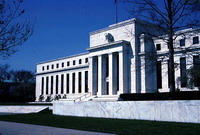Federal Reserve policymakers to slash interest rates
Federal Reserve policymakers at their September meeting felt compelled to act aggressively in lowering a key interest rate for the first time in over four years.

Fed policymakers unanimously agreed to slash interest rates by one-half percentage point to 4.75 percent, calling it "the most prudent course of action," according to minutes of the Sept. 18 meeting released Tuesday.
The minutes underscored just how concerned Fed Chairman Ben Bernanke and his central bank colleagues were that the credit crisis and the worst housing slump in 16 years could undermine America's economic health. The minutes offered fresh insights into the September meeting, where Bernanke was faced with one of his most important decisions since taking office in February of last year.
"Given the unusual nature of the current financial shock, participants regarded the outlook for economic activity as characterized by particularly high uncertainty, with the risks to growth skewed to the downside," according to the minutes.
On Wall Street, stocks rose sharply as investors viewed the minutes as indicating the Fed stands ready to lower rates again if needed. The Dow Jones industrials jumped 120.80 points to a new record close of 14,164.53.
Some Fed participants expressed concern that a weaker economy could worsen the credit crunch, which, in turn, could "reinforce the economic slowdown." At the same time, participants pointed out that in previous episodes of financial market disruptions, the economy showed some resilience when the country was suffering through a period of financial turbulence.
"Although financial markets were expected to stabilize over time, participants judged that credit markets were likely to restrain economic growth in the period ahead," the minutes said.
Lowering its main interest rate, called the federal funds rate, "was appropriate to help offset the effects of tighter financial conditions on the economic outlook," the minutes stated. The funds rate, the interest banks charge each other on overnight loans, affects a wide range of interest rates charged to millions of consumers and businesses. That is why it is the Fed's main tool for influencing national economic activity.
If the Fed did not lower rates, Fed policymakers "saw a risk that tightening credit conditions and an intensifying housing correction would lead to significant broader weakness" in the economy as well as in national employment conditions, according to the minutes.
Fed policymakers also believed that the rate cut "should not interfere" with lenders and other investors making the painful adjustments that they need to get their financial houses in order, the minutes said.
With economic growth likely to run at a sub-par pace for a while and incoming inflation data on the "favorable side," the lowering of rates "seemed unlikely to affect adversely the outlook for inflation," the minutes said.
The credit crunch was likely to deepen the housing slump, raised the possibility of dampening consumer spending and could weigh on business investment in the months ahead, the minutes said. Spending by consumers and businesses are crucial ingredients keep the economic expansion going.
Policymakers did not think that the job market had deteriorated as much as a government report at the time suggested. Nonetheless, they believed that "some further slowing of employment growth was likely."
The government originally reported that the U.S. economy lost 4,000 jobs in August - the first such decline in four years. At the time, that news sent Wall Street in a nosedive, intensified fears that the economy was heading toward recession and was seen as cementing a case for the Fed to lower rates at its September meeting.
Last week, however, the government released revised figures - based on more complete data - showing that employers actually added 89,000 jobs during that month.
Job-creation picked up in September, with employers boosting payrolls by 110,000. Workers' wages also grew solidly, the government reported last week. That news eased fears the economy would slide into a recession and cast doubt on whether the Fed would lower rates again at its next scheduled meeting, Oct. 30-31. Still, investors and some economists are hopeful the Fed will order another rate cut then.
Separately, William Poole, president of the Federal Reserve Bank of St. Louis, in a speech, said there are some signs that financial turmoil also is easing.
"Financial markets appear to be stabilizing, but they have not returned to normal and are still fragile," said Poole in comments similar to those made late last month.
The minutes also said that Fed policymakers discussed "additional policy options to address strains in money markets." No decisions were made and no details were provided. Policymakers also at the September meeting resumed a discussion on ways to improve their communications with Wall Street and Main Street. No decisions were made on that front, either.
Also contained in Tuesday's Fed document, was information about two Fed conference calls that occurred after its Aug. 7 meeting as credit conditions worsened.
The first conference call came on Aug. 10, a day when the Fed publicly pledged to do all it could to prevent the credit crisis from hurting the economy. The Fed pumped billions of dollars into the U.S. financial system to help financial companies get over the credit hump.
The second conference call came on Aug. 16, with Fed policymakers discussing other ways to bring relief to the credit situation. The talk focused on changes associated with lending through its discount window to banks. During that discussion, policymakers believed a reduction to the federal funds rate was "not yet warranted."
On Aug. 17, the Fed slashed its lending rate to banks and offered a more grim assessment of economic conditions. This bank lending rate was cut again at the Fed's meeting in September.
Subscribe to Pravda.Ru Telegram channel, Facebook, RSS!





